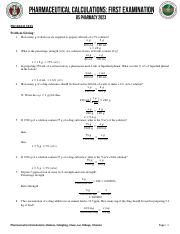


Pediatric and Geriatric Dose Calculations 181Ĭhapter 6 Drug Concentration Expressions 203Ħ.2.4. Dosage Based on Body Surface Area (BSA) 174ĥ.5. Calculations Involving Dose, Size, Number of Doses, Amount Dispensed, and Quanity of a Specific Ingredient in a Dose 161ĥ.4. Liquid–Liquid Aliquots and Triturations 131ĥ.1. The Meniscus and Effect of Viscosity 114Ĥ.5.3. Volumetric Devices for Pharmaceutical Measurements 114Ĥ.4.3.1. Minimum Weighable Quantity (MWQ) or Least Weighable Quantity (LWQ) 110Ĥ.4.3. Prescription Balances: Class A, Torsion 110Ĥ.4.2.1. Tolerance in Prescription Compounding and Pharmaceutical Manufacturing 108Ĥ.4.2.

Relative Error: Indication of Error Based on Percentage of Estimated Value 107Ĥ.3. Absolute Error: Indication of Error Based on Maximum Deviation and Significant Figures 104Ĥ.2.2. Calculations to Check “DEA” Numbers 77Ĭhapter 4 Weighing and Measuring in Pharmacy Practice 103Ĥ.2.1. Formulation Based on Single Dosage Unit 71ģ.8. Formulation Based on Total Quantity 70ģ.5.2.3.2. Prescriptions for Compounded Drug Products 69ģ.5.2.2.1. Prescriptions for Manufactured Drug Products 69ģ.5.2. Outpatient Prescription Drug Orders 69ģ.5.1. Practices to Prevent Medication Errors 58ģ.5. Household Equivalents and Metric Estimation 44Ĭhapter 3 Prescriptions and Medication Orders 54ģ.3. Reviews of the prior edition: ".a well-structured approach to the topic." (Drug Development and Industrial Pharmacy) and ".a perfectly organized manual that serves as a expert guide." (Electric Review)Ĭhapter 1 Review of Basic Mathematical Principles1Ģ.8.
PHARMACEUTICAL CALCULATIONS SOLUTION MANUAL PDF PROFESSIONAL
Rearranges chapters and rewrites topics of the previous edition, making its content ideal to be used as the primary textbook in a typical dosage calculations course for any health care professional.Maintains value for teaching pharmacy students the principles while also serving as a reference for review by students in preparation for licensure exams.Adds a new chapter dedicated to practical calculations used in contemporary compounding, new appendices, and solutions and answers for all problems.Connects well with the current emphasis on self-paced and active learning in pharmacy schools.Retaining the successful previous editions' programmed instructional format, this book improves and updates an authoritative textbook to keep pace with compounding trends and calculations – addressing real-world calculations pharmacists perform and allowing students to learn at their own pace through examples.


 0 kommentar(er)
0 kommentar(er)
